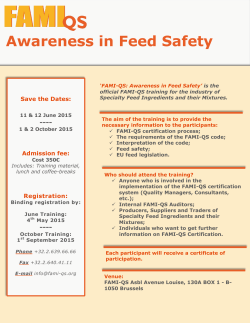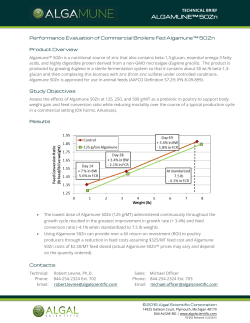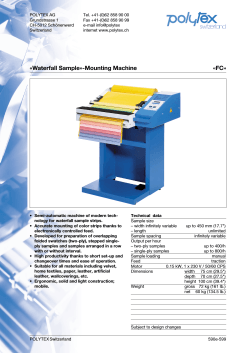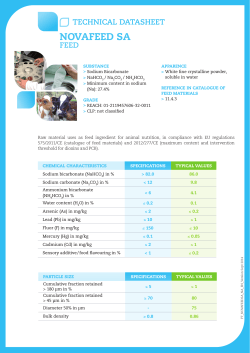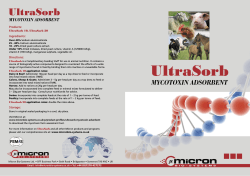
Feed Quality Assurance Programs for Feed Mills
Feed Quality Assurance Programs for Feed Mills Charles Stark, Ph.D. North Carolina State University Charles_stark@ncsu.edu Use of trade names in this publication does not imply endorsement by the North Carolina Agriculture Research Service or the North Carolina Cooperative Extension Service of the products mentioned. Types of Quality Programs ISO HACCP Safe Feed/Safe Food Comprehensive Quality Assurance Quality Control Program National Grain and Feed Association Quality Assurance Program Quality Assurance Ingredient Specification QA Lab Feed Manufacturing Regulatory & Certification Nutrients Levels Receiving Receiving FDA Rejection Procedures Analytical Processing Commercial Feed Law Claims Matrix Development Finished Feed HACCP, USDA Safe Feed/Safe Food Definitions Quality Assurance – comprehensive program of policies, procedures, and process controls that yield a consistent product. Quality Control – in-plant process measurements that insure quality parameters are met during receiving, manufacturing, and delivery. Quality Assurance vs. Quality Control Quality Assurance Examples Management Tasks 1. 2. 3. 4. 5. 6. Ingredient Specification Ingredient Analysis Plan Scale Testing Schedule Batch Tolerance Limits Medicated Sequence Finished Feed Assay Plan Quality Control Examples Employee Tasks 1. 2. 3. 4. 5. 6. Mycotoxin Assay Ingredient Moisture Particle Size Analysis Manufacturing Yields Conditioning Temp Set-point Pellet Quality Quality Assurance Manual - Sections Mission Statement Job Descriptions Training Program Quality Team Purchasing and Receiving Feed Manufacturing and Process Control Finished Feed Sampling, Inspection and Labeling Feed Shipment and Delivery Sanitation and Pest/Rodent Control Feed Product Investigations/Recalls Reports and Charts Critical Control Points Based on National Grain and Feed Association – Model Program and AFIA Safe Feed/Safe Food Mission Statement At our company, quality assurance is a way of doing business, not simply a program. It requires a partnership effort and a continuing commitment on behalf of management and employees. Total quality management makes good business sense. It is one of the ways our firm differentiates its products and services in the highly competitive marketplace in which we operate, something that is vitally important to the continued success of our company and to those of us who work here. Job Descriptions & Training Program Manager Supervisor Operators Task specific Competencies SOP training Evaluations Responsibilities Document all training Quality Assurance Teams A team should be formed to identify, evaluate, and control feed and food safety hazards. PURCHASING AND RECEIVING Quality Assurance Manual Purchasing and Receiving Overview/Objective Producing safe feed of desired quality starts with the grains and ingredients provided by suppliers. Purchasing and receiving standards represent the front line of defense in producing quality feeds. The quality of feed ingredients cannot be improved once they arrive at the mill. To help ensure that only quality ingredients are purchased and received, procedures need to be in place to provide guidance to employees performing these important purchasing and receiving functions. Grain and Feed Ingredient Purchasing Grain and feed ingredient specifications Ingredient Specification - (example) AAFCO Definition Typical Nutrient Analysis Analytical Method Physical Properties Basis for Rejection Suppliers Approved Supplier List List approval date & contact information Periodic visits to supplier New Supplier Requirements Submit 3 samples from different lots for evaluation prior to first shipment Certificates or guarantees of analysis Ship 5 loads that meet specifications Purchase Contracts • • • • Date of contract Description of ingredient Quantity Quality & Terms – – – – – – – – US Grade Mycotoxin level Price and payment terms Inspections and weights Trade Rules (NGFA, NOPA) Transportation specifications BSE Transportation Certificate Taxes and fees Receiving Check Shipping Documents Ingredient identification, supplier, hauler Name and location of shipment destination Delivery ticket Lot number Ingredient labeling Verify compliance with BSE regulations Confirm weights Compare shipper vs. receiver Check bag weights and number Receiving • Sample and check ingredient – Sample before unloading • Test and analyze according to the schedule – Check condition of truck • Biological, chemical, physical material – Check initial discharge – Retain sample for ___months • Check ingredient during unloading – Color, Texture, Odor, Moisture, Foreign material, Temperature Sampling Patterns Hopper Bottom Sample Pattern Dump Trailer Sample Pattern Rejection of Ingredient Quality Questions and Issues STOP THE UNLOADING PROCESS!! Contact the Manager Wait for management instructions from: Feed Mill Manager QA Manager Nutritionist Purchasing Agents Rejection of Ingredient Contact individual with rejection authority Examine the delivery vehicle Contact driver and transportation company Contact supplier: Same day or Next day Take pictures of ingredients and trailer Complete rejection report Soybean Meal Wheat Middlings x x x x Frequency x Gross Energy x Amino Acids x Fumonisin x Zearalenone x DON x Aflatoxin x Sodium x Phosphorus x Calcium x Fiber x Fat Moisture Corn Protein Analytical Schedule I-25 x x x x x C-500 I-25 x x x x x x x x x x x C-250 I-25 C-100 •Develop a schedule based on received volume of ingredients vs. time. •Schedules based on time will skew matrix values unless they are weighted. Receiving Tests Cereal Grain Moisture Soft Ingredient Moisture Corn Grading Mycotoxins www.romerlabs.com Ingredient Bulk Density Loose Pack Density Vibrated Density Compacted Density Ingredient Particle Size Particle size is typically specified based on material passing through a specific sieve. DDGS – 95% thru #10 Soybean Meal – 95% thru #10 Limestone – 99% thru #12 Salt – 90% thru #8 FEED MANUFACTURING AND PROCESS CONTROL Quality Assurance Manual Feed Manufacturing and Process Control – Overview/Objective • Maintaining consistent control over the quality and safety of the finished product requires applying quality assurance procedures at each step of the feed manufacturing process. Procedures have been developed for: – – – – Grinding operations Batching and mixing operations Bagging operations Feed production and clean-out Grinding Operation • Equipment – Maintain equipment according to manufacturer’s recommendations – Clean magnets daily – Inspect screens and hammers weekly – Adjust roll gaps daily; check roll parallel monthly • Visual inspection – Check hammermill and roller mill – Check appearance of ground grain – Check screens for holes Particle Size and Standard Deviation Roller mill Hammermill Dgw, μm (Sgw) Dgw, μm (Sgw) 1235 (1.98) 887 (1.83) 980 (2.52) 954 (2.49) 848 (1.84) 931 (2.49) 747 (2.03) 665 (2.49) 505 (2.02) 477 (2.25) 502 (1.97) 390 (2.12) Groesbeck, 2003 Particle Size Analysis Step #2 Rotap 10 min Step #1 Weigh 100 g Step #3 Record Weight Step #4 Calculate Particle Size Batching & Mixing • Equipment – Inspect scale hopper & mixer quarterly • Gates, Surge – Inspect micro drum/tub weekly – Check scales • Internally – weekly or monthly • Externally - 2-4 times a year • Major scale fill test – 1/3 full + test wt. – 2/3 full + test wt. – Zero scales daily or as needed – Check meters 4 times a year Batching & Mixing Equipment Inspect turn head, 2-way valves, spouting annually Perform mixer test Installation Annually (minimum), recommend twice a year Verify flushing procedures (Meds, Urea, BSE) Minimum of 10% of mixer capacity Installation Every three years Clean finished feed magnet weekly Batching & Mixing Master Formula File/Manufacturing Directions Mixing directions (Wet/Dry mix time) Original formula Formula entry employee Date & time of formula entry Verification by management Date & time of formula removal Copy of feed tag Computer feed tag printout (bulk & bag) Date & initial by management Batching & Mixing Verify Feed Formulation Manufacture according to formula Verify ingredients are approved for animal feed Check drug levels against medication bag & feed regulations Verify computer formula to paper copy “Master Formula File” Active vs. Archived formula 1 year past shipment Batching & Mixing Bulk Ingredients Weigh in descending order of weight to scale Bulk ingredient tolerances Warning/Alarm Accept/Reject policy Locate ingredient base on scale resolution and call amounts Batching System Micro Scale Major Scale Minor Scale Batching & Mixing Micro-system Check the weight of medication bags prior to dumping in the micro bins Verify the bins are labeled correctly Visually inspect bag vs. bin product When switching drug lot numbers the bin MUST run completely empty, record change on the production sheet Complete micro-bin bag dump log Batching & Mixing • Hand-adds – Check accuracy of scale – Open bags MUST remain in original bag • Roll over or seal when not in use – – – – Label scoops for each ingredient Weigh ingredients into weigh buggy or container Check off hand-adds on the formula sheet Record drug amount & lot # on the hand-add sheet. – Dispose of all spills • Record drug spills on drug recon sheet Batching & Mixing Batching Accuracy Major +/- ___ lbs/batch Minor +/- ___ lbs/batch Micro +/- ___ lbs/batch Liquid+/- ___ lbs/batch Weight Discrepancy Range 1-2% of batch Document policy and procedures for discrepancy Initial accepted under/over limits Batching & Mixing Mixer Fill Order 1. Major Scale Micro Scale Major Scale Minor Scale 2. Minor Scale 3. Micro Scale 4. Hand-add 5. Liquid Time delay scales1-3 sec after each discharge Batching & Mixing Typical mixing time Dry mix time 30 sec – 3 minutes Wet mix time 30 sec – 2 minutes Based on liquid amounts Validate mixing times CV< 10% Annually Discharge mixer after mixing is complete Batching & Mixing Mixing Plan/Sequence Group feed types Mix medicated feeds with the same drug from lowest to highest concentration Clean, flush or sequence according to policy BSE, Medication, Species, Age (market to starter) Highly toxic drugs - physical clean-out Use Flush/Sequence when possible Mixer Uniformity Tests - Quantab™ Step #1 Sample mixer Step #3 Add 90 ml distilled water Step #2 Weigh 10 g feed Step #4 Record strip reading Mixer Uniformity Evaluation CV RATING CORRECTIVE ACTION < 10% Excellent None 10-15% Good Increase mixing time by 25-30% 15‐20% Fair 20% + Poor Increase mixing time by 50%, look for worn equipment, overfilling, or sequence of ingredient addition Possible combination of all the above Consults extension personnel or feed equipment manufacturer Batching & Mixing Problems Fat sprayed on ribbon and shaft Fat balls created by poor application and mixing Pelleting • Pelleting Parameters – Conditioning temperature – Die specification – Conditioning time • Pick arrangement • RPM • Pelleting Report – Formula – Tons – Die size & length Cooling Parameters Cooler bed depth Final moisture content Pellet temperature +/- 5 F of ambient Weather conditions Air temperature Humidity www.bliss-industries.com Batching Records Feed Production Records Date/Time Formula Name/Number Lot number Number of batches Theoretical vs. actual production Location of feed after mixing Operators name Production Records • Daily production records – – – – – – – – – Feed production reports Feed delivery reports Receiving reports Bulk ingredient inventory Bag ingredient inventory Feed inventory Micro bin inventory Drug reconciliation Maintenance items • Boiler, magnets Production Records Drug Reconciliation Daily Count full bags Weigh opened bags Determine the quantity in the micro system Per Shift Bags added to micro system Reconcile Theoretical vs. Actual use Feed Manufacturing Tests KSU PDI Test Particle Size Analysis Mixer Evaluation NIR FINISHED FEED SAMPLING, INSPECTION AND LABELING Quality Assurance Manual Finished Feed Sampling, Inspection and Labeling Overview/Objective Inspection and sampling of bulk and bagged feeds is important to ensure the quality and integrity of the feeds supplied to customers. In addition, regulatory and feed control agencies may require specific feed labels. Finished Feed Testing Visual Inspections Uniform color and texture Nutrient Content Moisture, Protein, Fat – 2-3 samples/wk Moisture, Protein, Fat, Ca, P, Na – 5-6 samples/month Pelleted Feed Pellet Fines Pellet Quality (PDI) Finished Feed Analysis Moisture Protein Gross Energy Pellet Quality Tests Step #1 Whole Pellets Step #3 Weigh back Pellets Step #2 Test Sample Holmen Kansas State PDI FEED SHIPMENT AND DELIVERY Grower I Loading Procedures Load-Out Flushing Procedures Medicated(withdrawal) Non Non Non Non Med Med Med Med Non Med Med Med Med Med Delivery Unloading Unload from the back compartment first Open one compartment at a time Flush or sequence between feeds if required Document the unloading sequence if other than back to front Confirm the compartments are empty Report all feed spills and note on ticket Check to ensure the bulk bin lid is closed Delivery Trailers Cleanout/Flushing Points Top Compartment Lift Auger Floor Auger Delivery Reports Emergency Outs Code based on reason Feed mill Grower/Customer Tons hauled per driver Tons returned Average tons per load SANITATION AND PEST/RODENT CONTROL Feed Mill Pests Stored-Product Insects Beetles (Coleoptera) Moths (Lepidoptera) Mites (Psocoptera) Rodents Norway rat Roof rat House mouse Birds Pigeons European starlings House sparrows All damage product Some damage equipment or mill structures All are potential carriers of disease Pesticide and Baiting Program • Rodent control – Licensed employee – Pest control company • Bird control – Pest control company • Pest Control Contractor – – – – License and contract on file MSDS/Safety information on products Written report Accompany contractor on each monthly visit Inspection Routine Inspections Tall weeds and grass Debris that harbors rodents (pallets) Equipment that is stored close to the building Proper drainage (no standing water) Feed mill roof for leaking bucket elevators, spouting, cyclones, bag houses, exhaust fans Feed Mill Sanitation A safe, clean and well maintained feed mill does not “just happen” it takes the efforts of management, operators and maintenance. Management has to set the example and standards Operators need to alert management about potential problems before breakdowns occur Maintenance needs to work with operators to keep equipment maintained and sealed to prevent dust leaks Sanitation Promptly clean up grain spills and litter from inside and outside of the plant Pallets should be stacked neatly Broken bags taped and product cleaned up ASAP Sanitation Program Operators assigned areas Sanitation crew – rotation based on priority Regular mill shutdowns FEED INVESTIGATIONS & RECALLS Recall Steps Identify the Problem Notify the Recall Leader Collect Contact information Notify “Top Management” Review production data and laboratory analysis Determine type and quantity of products involved Evaluate the severity and determine the action Recall (Yes/No) Regulatory notification (Yes/No) Quality Assurance Manual Feed Product Investigations/Recalls Overview/Objective Each step in feed quality assurance is designed to ensure that the customer is provided with consistently safe, wholesome feed products. Despite the best of efforts, there may be occasions when a customer voices a complaint or lodges a claim or product liability suit, alleging that the feed was inferior and resulted in substandard performance by the animals to which it was fed. There also may be occasions when a product recall becomes necessary because of a quality or labeling error. Types of recalls External Recall: Removal of the product from the market after distribution has been made beyond the direct control of the feed company where it was manufactured. Internal Recall: Removal of the product from the market, none of which has been distributed beyond the direct control of the feed company where it was manufactured. Retention: The temporary withholding of the product from the market or from further processing or shipment by the company because of evidence that the product does not meet the quality specifications of the formula and/or the label. Recall Team Recall Leader (Data Collector) Production or Sales Research/Nutrition/Quality Assurance Feed Manufacturing Communications Legal Counsel Top Management Take Home Message • Determine Goals and Objectives for the Quality Assurance Program • Develop a Quality Assurance Manual – Ingredients Specifications – Processing Parameters/Targets – Standard Operating Procedures • Train Employees • Monitor Results – Statistical Process Control – Concise Reports Questions NC State Feed Mill Education Unit
© Copyright 2025
